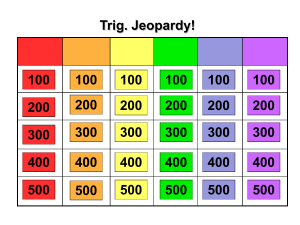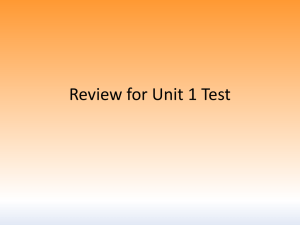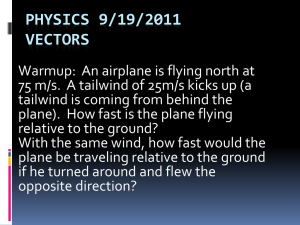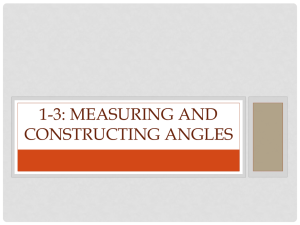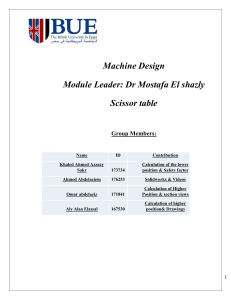STATICS LECTURE
advertisement
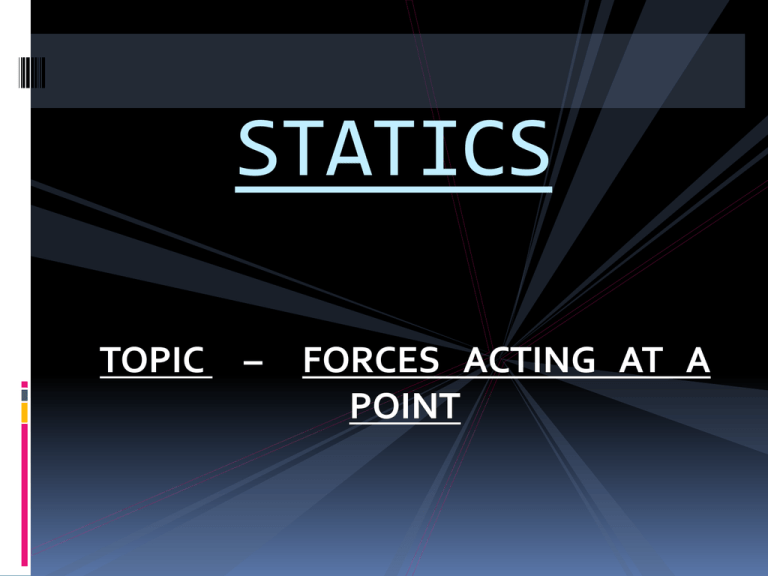
STATICS TOPIC – FORCES ACTING AT A POINT RESULTANT AND COMPONENTS RESULTANT AND COMPONENTS If two or more forces act upon a rigid body and if a single force can be found such that the effect of it upon the body is same as that of all the forces taken together, then the single force is called the RESULTANT of the forces and the given forces themselves are called COMPONENT OF FORCES. NOTE: Forces are said to be in EQUILLIBRIUM if there is no resultant force. PARALLELOGRAM LAW OF FORCES PARALLELOGRAM LAW OF FORCES If two forces acting at a point be represented in magnitude and direction by the two sides of a parallelogram through the point of application , their resultant will be completely represented by the diagonal of the parallelogram through that point. B Q O C R P A OA + OB = OC MAGNITUDE AND DIRECTION OF RESULTANT Let two given forces P and Q acting at at an angle α be represented in magnitude and direction by OA and OB resp.. Complete the parallelogram OABC then the resultant R is represented in magnitude and direction by the diagonal OC.Draw CD perpendicular to OA as in fig. B C R Q α 180-α θ O α P A OA + OB = OC Since AC and OB are the parallel and equal ,therefore AC will also represent the force Q. Also since angle AOB=α, thus angle CAD=α and 180- α in fig. OD=OA+AD = OA+AC+AC.AD/AC=P+Q cosα And CD=AC sinα=Q sinα OD=OA-DA = P-Q cos (180-α ) = P+Q cos α CD=Q sinα OD=P+Q cosα andCD=Qsinα Now in right angle OCD OC²=OD²+CD² R=(P+QCOSα)+(Qsinα) R=sqrt(P²+Q²+2Pqcosα) and tanθ=CD/OD =Qsinα/(P+Qcosα) DEDUCTIONS COR.1 if ø be the angle which the resultant makes with OB ,then tan ø = P sin α/(Q+P cos α) COR.2 If the two forces P and Q are perpendicular to one another i.e. if α=π/2 Then R=√(P²+Q²+2PQcosπ/2) R=√(P²+Q²) And Tanθ=Qsin π /2/(P+Qcos π /2)=Q/P COR.3 If P=Q i.e. if two forces are equal then R=√(P²+P²+2P²cosα) =√(2P²(1+cosα)) =√(2P²(2cos²α/2)) therefore R=2Pcosα/2 And tanθ=Psinα/(P+Pcosα)=sinα/(1+cosα) =tanα/2 θ =α/2 COR 4. If P>Q, then P+Qcosα>Q+Qcosα i.e (P+Qcosα)/(Qsinα)>(Q+Qcosα)/(Qsinα) Dividing throughout by Qsinα,we get Qsinα/(P+Qcosα)<sinα/(1+cosα) Tanθ<(2sinα/2.cosα/2)/2cosα/2 Tanθ<tanα/2 θ<α/2 COR. 5 Maximum value of resultant: We have R²=P²+Q²+2PQcosα……………………………(1) From (1) R is maximum when cosα is maximum .But maximum value of cosα =1 i.e. Whenα =0˚ Therefore R²=P²+Q²+2PQ=(P+Q)² R=P+Q COR.6 Minimum value of resultant: We have R²=P²+Q²+2PQcosα…………..(1) From (1), R is minimum when cosα is minimum. But minimum value of cosα =-1 i.e. α =180˚ Therefore ,R²=P²+Q²+2PQ(-1) R²=(P-Q)² Therefore ,R=P-Q EXAMPLE :1 Find the magnitude and direction of the resultant of two forces of magnitudes 12N and 14N ,acting at a point and inclined to each other at an angle of 45 ˚. B C 14 R 45˚ θ O 12 A SOLUTION Let P=12N , Q=14N and let R be the resultant acting at O ,making an angle θ with P (=12N) .also α = 45˚ Therefore R=√(P²+Q²+2PQcosα) =√((12)²+(14)²+2.12.14.cos45˚) =√(144+196+168.√2) =√(144+196+168.(1.414)) =√577.552 =24.03N Also Tanθ=Qsinα/(P+Qsinα) =14.sin45˚/(12+14.sin45˚) =14.(1/√2)/(12+14.(1/√2)) =14/(12.√2+14) =0.45 Therefore θ=tan ־¹(0.45) Thus the resuLtant is of magnitude 24.03N and makes an angle of tan־¹ (0.45)with the direction Of force 12N. ASSIGNMENT 1.Two forces of magnitudes 8N and 6N acts at a point and the angle between them is 60 ˚.find the magnitude and direction of their resultant ? 2. Find the angle between two forces P,P when the square of their resultant is equal to (2-√3) times their product? 3.Two forces acting at a point are such that if the direction of one is reversed the direction of resultant is turned through a right angle prove that the forces must be equal in magnitude? 4.Two forces P and Q have a resultant R .if the force P be increased then the new resultant bisect the angle between R and P .find the increase in P? 5.When two equal forces are inclined at an angle 2α their resultant is twice as great as when they are inclined at an angle 2β . Prove that cosα=2cosβ ? 6.The resultant R of forces P and Q makes an angle 2θ with the line of action P .P is now replaced by P+R , Q remaining unchanged .show that the resultant makes an angle θ with P? TEST NOTE: do any two ? 1.To find the magnitude and direction of the resultant of two forces acting at a point ? 2.Two forces P and 2P acts on a particle if the first be doubled and the second be increased by 10 kg weight . The direction of the resultant is unaltered . Find the value of P? 3. The resultant of forces P and Q is R .if Q be doubled ,R is doubled, if Q be reversed , R is again doubled . Show that P²:Q²:R²=2:3:2 or P:Q:R=√2:√3:√2 4. two forces P+Q and P-Q makes an angle 2α with one another and their resultant makes an angle ‘θ’with the bisector of angle between them .show that Ptanθ=Qtanα?




